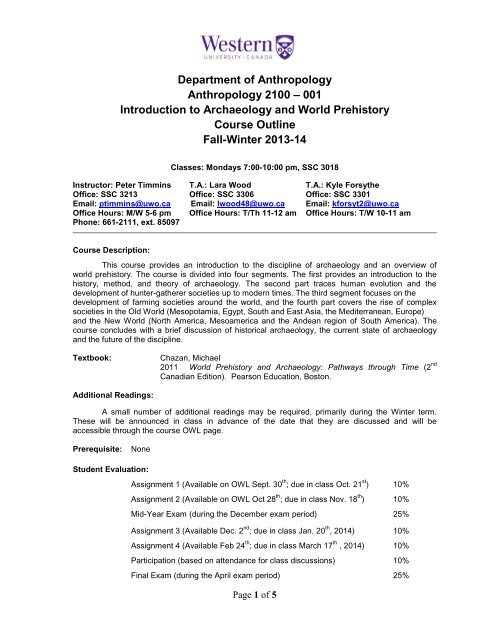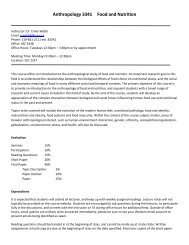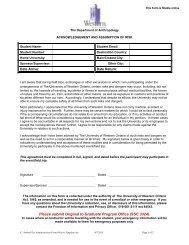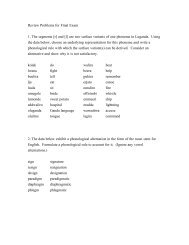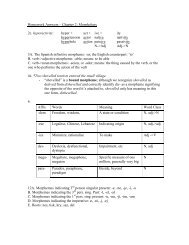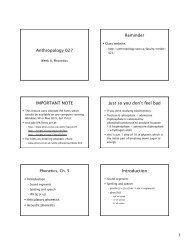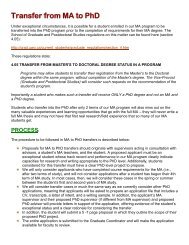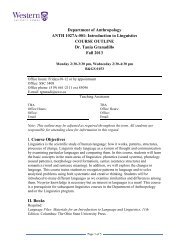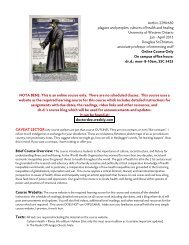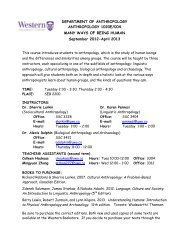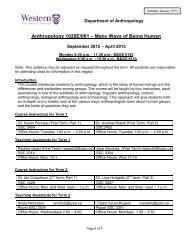Archaeology and World Prehistory - Anthropology
Archaeology and World Prehistory - Anthropology
Archaeology and World Prehistory - Anthropology
You also want an ePaper? Increase the reach of your titles
YUMPU automatically turns print PDFs into web optimized ePapers that Google loves.
Department of <strong>Anthropology</strong><strong>Anthropology</strong> 2100 – 001Introduction to <strong>Archaeology</strong> <strong>and</strong> <strong>World</strong> <strong>Prehistory</strong>Course OutlineFall-Winter 2013-14Classes: Mondays 7:00-10:00 pm, SSC 3018Instructor: Peter Timmins T.A.: Lara Wood T.A.: Kyle ForsytheOffice: SSC 3213 Office: SSC 3306 Office: SSC 3301Email: ptimmins@uwo.ca Email: lwood48@uwo.ca Email: kforsyt2@uwo.caOffice Hours: M/W 5-6 pm Office Hours: T/Th 11-12 am Office Hours: T/W 10-11 amPhone: 661-2111, ext. 85097Course Description:This course provides an introduction to the discipline of archaeology <strong>and</strong> an overview ofworld prehistory. The course is divided into four segments. The first provides an introduction to thehistory, method, <strong>and</strong> theory of archaeology. The second part traces human evolution <strong>and</strong> thedevelopment of hunter-gatherer societies up to modern times. The third segment focuses on thedevelopment of farming societies around the world, <strong>and</strong> the fourth part covers the rise of complexsocieties in the Old <strong>World</strong> (Mesopotamia, Egypt, South <strong>and</strong> East Asia, the Mediterranean, Europe)<strong>and</strong> the New <strong>World</strong> (North America, Mesoamerica <strong>and</strong> the Andean region of South America). Thecourse concludes with a brief discussion of historical archaeology, the current state of archaeology<strong>and</strong> the future of the discipline.Textbook:Chazan, Michael2011 <strong>World</strong> <strong>Prehistory</strong> <strong>and</strong> <strong>Archaeology</strong>: Pathways through Time (2 ndCanadian Edition). Pearson Education, Boston.Additional Readings:A small number of additional readings may be required, primarily during the Winter term.These will be announced in class in advance of the date that they are discussed <strong>and</strong> will beaccessible through the course OWL page.Prerequisite:NoneStudent Evaluation:Assignment 1 (Available on OWL Sept. 30 th ; due in class Oct. 21 st ) 10%Assignment 2 (Available on OWL Oct 28 th ; due in class Nov. 18 th ) 10%Mid-Year Exam (during the December exam period) 25%Assignment 3 (Available Dec. 2 nd ; due in class Jan. 20 th , 2014) 10%Assignment 4 (Available Feb 24 th ; due in class March 17 th , 2014) 10%Participation (based on attendance for class discussions) 10%Final Exam (during the April exam period) 25%Page 1 of 5
Assignments:The assignments are relatively brief written exercises that review specific sections of thecourse material. They are not essays. Each assignment is expected to be approximately 1200-1500words in length. Assignments are to be h<strong>and</strong>ed in at the beginning of class on their due dates. Theyare to be submitted in hard copy with a backup electronic copy submitted through OWL.Assignment 1 will be a short exercise in archaeological method <strong>and</strong> theory based on the firstthree lectures. Assignment 2 deals with the development of stone tool technology during thePaleolithic period. Assignment 3 concerns technological <strong>and</strong> socio-political changes associated withthe development of agriculture. Assignment 4 involves a comparison of major features of two ancientOld <strong>World</strong> civilizations.Late Policy: There will be a 2% reduction of the assignment grade for each day that anassignment is late (including weekends <strong>and</strong> holidays). Assignments that are not h<strong>and</strong>ed in withinthree weeks of the due date may receive a grade of zero.ExamsExams will be based on material covered in lectures, in the assigned readings, <strong>and</strong> inPowerPoint presentations <strong>and</strong> videos presented during the course. Exams will consist of acombination of multiple choice <strong>and</strong> short answer questions. The December exam will cover the firstterm <strong>and</strong> the April exam will cover the second term. The final exam is not cumulative.OWLOWL (powered by Sakai) is Western’s online course management program. The course OWLwebpage will be used to communicate with the class. Students are advised to check the OWL pagefor announcements <strong>and</strong> important course materials. PowerPoint presentations used in lectures will bemade available online through OWL after each lecture. The course syllabus <strong>and</strong> assignments will alsobe available through OWL. In addition to submitting a hard copy of assignments in class, students willbe expected to submit electronic copies of assignments through OWL prior to the assignment duedate. While marked hard copies of assignments will be returned to students, assignment grades willalso be posted in the markbook on the course OWL site. Mid-term exam marks, final exam marks <strong>and</strong>final course grades will also be posted in the OWL markbook.ParticipationParticipation marks will be based on attendance in class for discussion questions on currentissues in archaeology or activities such as identifying early human fossils <strong>and</strong> their specificcharacteristics, identifying artifacts, archaeological sites, monumental structures, etc. Thesediscussions <strong>and</strong> activities will take place after the relevant topics have been discussed in class,however, they will not follow a set schedule <strong>and</strong> may occur at any time during lectures.Academic OffensesAcademic offences are taken seriously <strong>and</strong> students are directed to read the appropriatepolicy, specifically, the definition of what constitutes a Scholastic Offence, at the following Web site:http://www.uwo.ca/univsec/h<strong>and</strong>book/appeals/scholoff.pdf.Plagiarism: Students must write their assignment in their own words. Whenever students take<strong>and</strong> idea, or a passage from another author, they must acknowledge the source using properreferencing. Follow the referencing style used in the course text. Plagiarism is a major academicoffence (see the definition of a Scholastic Offence at the Web address noted above).Page 2 of 5
Statement on the Use of Electronic Devices:As a matter of courtesy, please mute phones during lectures. Laptops <strong>and</strong> tablets may beused for note-taking <strong>and</strong> when the instructor makes use of online resources during class. If you wishto record lectures, please seek permission from the instructor.No electronic devices (including but not limited to laptop computers, cell phones, tablets,etc…) will be allowed during examinations, unless expressly authorized by the instructor.Missed Mid-Year Exams:If, for medical or non-medical reasons, you are unable to write the Mid-Year exam you mustcontact the Instructor, preferably prior to the scheduled date of the exam. You should be prepared toprovide documentation supporting the reason for the missed exam. In the case of exams missed formedical reasons, refer to the UWO Medical Accommodation Policy found at:http://www.uwo.ca/univsec/h<strong>and</strong>book/appeals/accommodation_medical.pdf.Missed Final Exams:If, for medical or non-medical reasons you are unable to write the final exam, you will requirethe permission of the Dean of your home faculty, the Instructor, <strong>and</strong> the Chair of the Department of<strong>Anthropology</strong> to write a special final exam. You must contact the Academic Counseling Office torequest permission to write a special exam <strong>and</strong> obtain the necessary form. The student must ensurethat the form is signed by the Instructor <strong>and</strong> the Department Chair before it is returned to theappropriate Academic Counseling Office in the student’s faculty. In the case of exams missed formedical reasons, the provisions of the UWO Medical Accommodation Policy apply:http://www.uwo.ca/univsec/h<strong>and</strong>book/appeals/accommodation_medical.pdf.Support Services <strong>and</strong> AccessibilityStudent Development Services offers a variety of academic, personal, <strong>and</strong> career-relatedservices to assist students. The Student Development Centre is located in Room 4100 of the StudentServices Building <strong>and</strong> their web site is: http://www.sds.uwo.ca/. Please contact the course instructor ifyou require material in an alternate format or if you require any other arrangements to make thiscourse more accessible to you. You may also wish to contact Services for Students with Disabilities(SSD) at 661-2111, x 82147 for any specific question.Students who are in emotional/mental distress should refer to Mental Health@Westernhttp://www.uwo.ca/uwocom/mentalhealth/ for a complete list of options about how to obtain help.The web site for the Office of the Registrar is: http://www.registrar.uwo.ca/.Lecture Schedule (tentative):Sept. 9Sept. 16Sept. 23Lecture 1: Introduction <strong>and</strong> History of <strong>Archaeology</strong>Readings: <strong>World</strong> <strong>Prehistory</strong> <strong>and</strong> <strong>Archaeology</strong>,Part One: Introduction, p. 1-5 <strong>and</strong> all of Chapter 2Lecture 2: More History of <strong>Archaeology</strong>Procedures of <strong>Archaeology</strong> IReadings: <strong>World</strong> <strong>Prehistory</strong> <strong>and</strong> <strong>Archaeology</strong>, Chapter 1.Lecture 3: Procedures of <strong>Archaeology</strong> IIReadings: <strong>World</strong> <strong>Prehistory</strong> <strong>and</strong> <strong>Archaeology</strong>, Chapter 1 <strong>and</strong> Appendix D.Page 3 of 5
Sept. 30Oct. 7Oct. 14Oct. 21Oct. 28Nov. 4Nov. 11Nov. 18Nov. 25Dec. 2Lecture 4: Human OriginsReadings: <strong>World</strong> <strong>Prehistory</strong> <strong>and</strong> <strong>Archaeology</strong>, Part Two: Introduction, p. 54-61, Chapter 3, p. 62-69 <strong>and</strong> Appendix C.Assignment 1 available on OWLLecture 5: From Early Homo to Homo erectus/Homo ergasterReadings: <strong>World</strong> <strong>Prehistory</strong> <strong>and</strong> <strong>Archaeology</strong>, Chapter 3, p. 69 – 89,Chapter 4, p. 90 – 100.Thanksgiving HolidayLecture 6: The Ne<strong>and</strong>erthals <strong>and</strong> the Origin of Modern HumansReadings: <strong>World</strong> <strong>Prehistory</strong> <strong>and</strong> <strong>Archaeology</strong>, Chapter 4, p. 100-119,Chapter 5, p. 120-136.Assignment 1 due in classLecture 7: The Upper PaleolithicReadings: <strong>World</strong> <strong>Prehistory</strong> <strong>and</strong> <strong>Archaeology</strong>, Chapter 5, p. 136-148Assignment 2 available on OWLLecture 8: Lecture 7: The Peopling of Australia <strong>and</strong> the New <strong>World</strong>Readings: <strong>World</strong> <strong>Prehistory</strong> <strong>and</strong> <strong>Archaeology</strong>, Chapter 6, p. 150-174Lecture 9: Hunter-Gatherers in the New <strong>World</strong>Readings: <strong>World</strong> <strong>Prehistory</strong> <strong>and</strong> <strong>Archaeology</strong>, Chapter 6, p. 174-181,Lecture 10: The Origins of Food Production <strong>and</strong> Early Food Production inthe Near East <strong>and</strong> EuropeReadings: <strong>World</strong> <strong>Prehistory</strong> <strong>and</strong> <strong>Archaeology</strong>, Part Three: Perspectives onAgriculture, p. 182-191 <strong>and</strong> Chapter 7.Assignment 2 due in classLecture 11: Farming Societies in the AmericasReadings: <strong>World</strong> <strong>Prehistory</strong> <strong>and</strong> <strong>Archaeology</strong>, Chapter 8 <strong>and</strong> Chapter 9,Section 9.3.Lecture 12: Early Farmers in Africa, East Asia <strong>and</strong> the PacificReadings: <strong>World</strong> <strong>Prehistory</strong> <strong>and</strong> <strong>Archaeology</strong>, Chapter 9Assignment 3 available on OWLDecember Exam Period MID-YEAR EXAMWinter Term (tentative):Jan. 6Jan. 13Lecture 13: The Development of Social <strong>and</strong> Political ComplexityReadings: <strong>World</strong> <strong>Prehistory</strong> <strong>and</strong> <strong>Archaeology</strong>, Part Four: Introduction, p.264-271.Lecture 14: The Rise of the State in MesopotamiaReadings: <strong>World</strong> <strong>Prehistory</strong> <strong>and</strong> <strong>Archaeology</strong>, Chapter 11, Intro <strong>and</strong> Section11.1.Page 4 of 5
Jan. 20Jan. 27Feb. 3Feb. 10Feb. 17Feb. 24March 3March 10March 17March 24March 31April 1April 7Exam PeriodLecture 15: Ancient Egypt <strong>and</strong> Sub-Saharan AfricaReadings: <strong>World</strong> <strong>Prehistory</strong> <strong>and</strong> <strong>Archaeology</strong>, Chapter 11, Section 11.2 <strong>and</strong>11.3 <strong>and</strong> Chapter 10, Section 10.5.Assignment 3 due in classLecture 16: The Development of Complex Societies in the Indus ValleyReadings: <strong>World</strong> <strong>Prehistory</strong> <strong>and</strong> <strong>Archaeology</strong>, Chapter 12, Section 12.2Lecture 17: The Development of Complex Societies in Southeast Asia <strong>and</strong>ChinaReadings: <strong>World</strong> <strong>Prehistory</strong> <strong>and</strong> <strong>Archaeology</strong>, Chapter 12, Intro <strong>and</strong> Section12.3.Lecture 18: Minoan <strong>and</strong> Mycenaean Civilization <strong>and</strong> the Development ofComplexity in EuropeReadings: <strong>World</strong> <strong>Prehistory</strong> <strong>and</strong> <strong>Archaeology</strong>, Chapter 12, Section 12.1 <strong>and</strong>Chapter 10, Intro <strong>and</strong> Section 10.2No Class (Reading Week)Lecture 19: Complex Societies in North AmericaReadings: <strong>World</strong> <strong>Prehistory</strong> <strong>and</strong> <strong>Archaeology</strong>, Chapter 10, Section 10.1 <strong>and</strong>Section 10.3Assignment 4 available on OWLLecture 20: The Development of Complex Societies in MesoamericaReadings: <strong>World</strong> <strong>Prehistory</strong> <strong>and</strong> <strong>Archaeology</strong>, Chapter 13, Intro <strong>and</strong> Section13.1 <strong>and</strong> 13.2Lecture 21: The Maya <strong>and</strong> the Aztec EmpireReadings: <strong>World</strong> <strong>Prehistory</strong> <strong>and</strong> <strong>Archaeology</strong>, Chapter 13, Sections 13.3<strong>and</strong> 13.4Lecture 22: The Development of Complex Societies in Andean SouthAmerica <strong>and</strong> the Inca EmpireReadings: <strong>World</strong> <strong>Prehistory</strong> <strong>and</strong> <strong>Archaeology</strong>, Chapter 14.Assignment 4 due in classLecture 23: The <strong>Archaeology</strong> of European Contact IReadings: to be announcedLecture 24: The <strong>Archaeology</strong> of European Contact IILecture 25: Contemporary Issues <strong>and</strong> the Future of <strong>Archaeology</strong>,Readings: <strong>World</strong> <strong>Prehistory</strong> <strong>and</strong> <strong>Archaeology</strong>, Epilogue, p. 416-421.Lecture 26: Catch Up <strong>and</strong> ReviewFINAL EXAM (covers second half of course)Page 5 of 5


